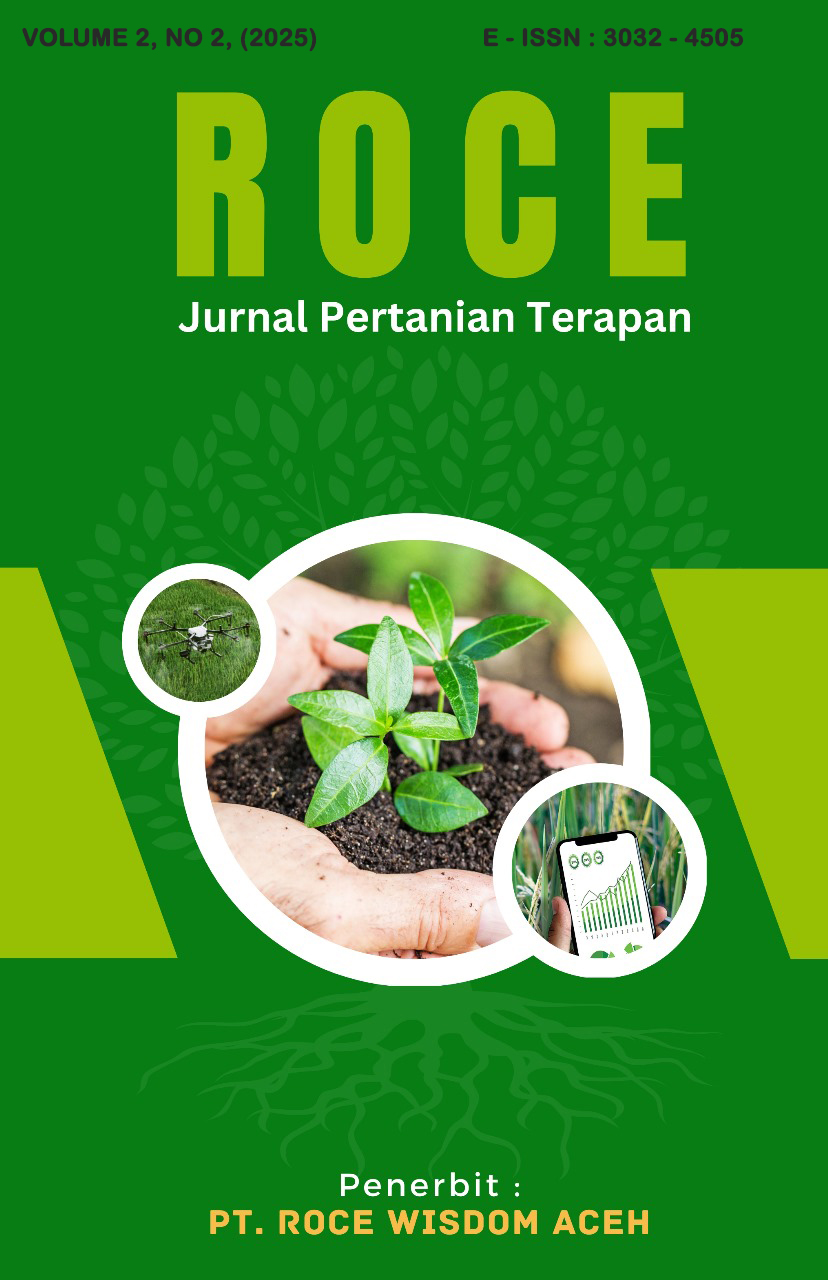SOIL ERODIBILITY ANALYSIS AND SOIL CONSERVATION TECHNIQUE IN THE BAWANG GAJAH SUB-WATERSHED, CENTRAL ACEH REGENCY
ANALISIS ERODIBILITAS TANAH DAN TEKNIK KONSERVASI TANAH DI SUB-DAS BAWANG GAJAH KABUPATEN ACEH TENGAH
DOI:
https://doi.org/10.71275/roce.v2i2.122Keywords:
Soil Erodibility, Soil Conservation, Bawang Gajah Sub-WatershedAbstract
Soil erodibility is the ease with which soil is destroyed by the force of falling raindrops and/or surface runoff. This study aims to determine the soil erodibility value and soil conservation techniques in the Bawang Gajah sub-watershed. The method used in this study is a survey method consisting of preparation, preliminary survey, primary survey, data analysis, and presentation of results. Soil erodibility values were calculated using the Wischmeier and Smith equation. The results of the soil erodibility analysis showed that low soil erodibility values ranging from 0.27, 0.28, and 0.37 were found in Land Mapping Unit (LMU) 2, 4, 5, and 10, moderate soil erodibility values of 0.43 and 0.51 are found in LMU 6 and 7, high soil erodibility values of 0.61 and 0.64 are found in LMU 3 and 11. Very high soil erodibility values of 0.82 and 0.92 are observed in LMU 9 and 14, respectively. The conservation techniques that must be implemented on LMU 2, 4, 5, and 10 are planting ground cover vegetation, applying mulch, and practicing crop rotation. The conservation techniques to be applied to LMU 6 and 7 are a combination of agroforestry and contour terraces, along with the planting of vetiver grass. The soil conservation techniques that must be applied at LMU 3 and 11 are agroforestry and reforestation, as well as the construction of contour terraces for the rehabilitation of eroded areas, while at LMU 9 and 14, the soil conservation measures implemented are the construction of terraces equipped with diversion channels, terrace channels, and drainage channels.Downloads
References
Ariyanti, M., Yahya, S., Murtilaksono, K., Suwarto, & Siregar. (2016). The effect of Nephrolepis biserrata ground cover plants and gulud terraces on surface runoff and oil palm (Elaeis guineensis Jacq.) growth. Jurnal Kultivasi, Vol. 15 No. 2.
Arsyad, S. (2010). Soil and Water Conservation. Bogor: IPB Press Series.
Asdak, C. (2002). Hydrology and River Basin Management. Yogyakarta: Gadjah Mada University Press.
[BPDAS Aceh] Aceh Watershed Management Agency. (2023). Database and information. Krueng Aceh Watershed Management Agency. Aceh Province.
[BMKG] Meteorology, Climatology and Geophysics Agency. (2025). Climate data. Malikussaleh Station, North Aceh.
Dai, R., Dai, C., Hou, S., He, Q., Liu, B., Huang, M., ... & Xu, X. (2023). Opportunities and challenges of hydrotalcite-related electrocatalysts for seawater splitting: a systematic perspective from materials synthesis, characterization, and application. Journal of Materials Chemistry A, 11(38), 20383–20407.
[DLHK] Department of Environment and Forestry. (2024). Land Use Data. Aceh Province.
Hananto, A., Ruslan, M., & Kadir, S. 2023. Erosion Hazard Levels in Forest and Land Rehabilitation in the Riam Kiwa Sub-Watershed, Banjar Regency. Journal of Tropical Forestry, Vol. 10 (2).
Nesa, M. M., Propa, S. M., Sen, S., & Abdullah, H. M. (2024). Land Use Change and Soil Erosion: Challenges and Way Forward to Management. In Climate Change and Soil-Water-Plant Nexus: Agriculture and Environment (pp. 547-571). Singapore: Springer Nature Singapore.
Suprayogo, D., van Noordwijk, M., Hairiah, K., Meilasari, N., Rabbani, A.L., Ishaq, R.M., & Widianto, W. (2020). Infiltration-Friendly Agroforestry Land Uses on Volcanic Slopes in the Rejoso Watershed, East Java, Indonesia. Journal Land, 9(8), 240.
Wahyudi. (2022). Soil Conservation Techniques and Their Implementation on Degraded Lands in Forest Areas. Journal of Environmental Science & Technology, Vol. 6, Iss. 2.
Wang, G., Ren, Y., Bai, X., Su, Y., & Han, J. (2022). Contributions of beneficial microorganisms in soil remediation and quality improvement of medicinal plants. Plants, 11(23), 3200.
Wischmeier, WH and Smith. DD. (1978). Predicting Rainfall Erosion Losses. A guide to conservation planning. USDA. Agric. Eng 29: 458 – 462.
Xuan, W., Zhenyu, L., Yongjun, C., & Yongsheng, Y. (2023). Influence of Vetiver Root Morphology on Soil–Water Characteristics of Plant-Covered Slope Soil in South Central China. Sustainability, Vol. 15, No. 2: 1365.
Downloads
Published
Issue
Section
License
Copyright (c) 2025 Halim Akbar, Rini Fitri (Author)

This work is licensed under a Creative Commons Attribution-ShareAlike 4.0 International License.













